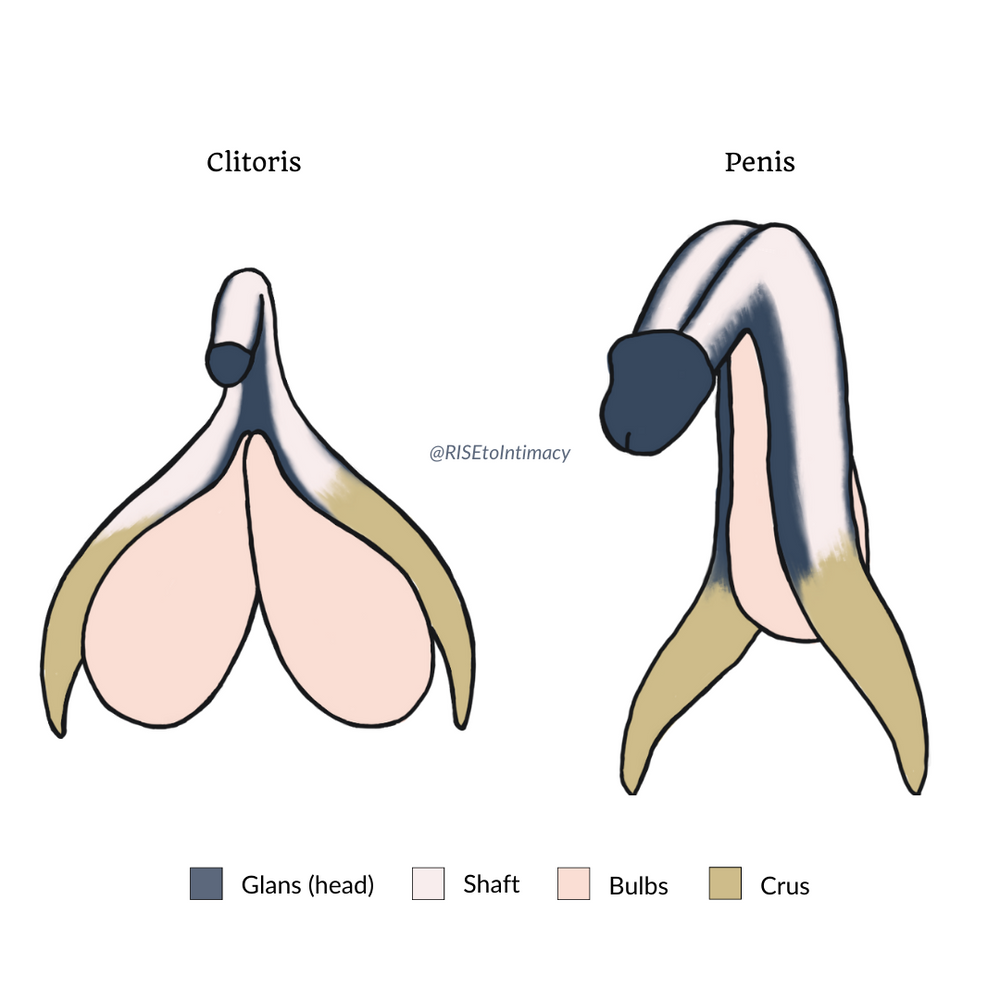February 9, 2025
Tips and Techniques for Improving Intimacy with Your Partner

A client recently told me, “I love to please my partner but she doesn't enjoy when I go down on her. I keep hearing that I should pay attention to the clitoris more, but she doesn't seem to enjoy it. What am I doing wrong?”
And the truth is, I get questions like this all the time in my private practice.
The short answer: Ask the clitoris in question.
Communication is everything when it comes to pleasuring a clitoris. Because each individual is different. Not only in anatomy—but also in experience, desire, comfort level, and sensitivity.
Plus of course, the clitoris is not just that little button nestled in folds. That’s just the tip. The rest of the organ is buried beneath the surface. Four distinct parts; each designed to receive slightly different versions of sexual stimulation.
4 parts of a clitoris:
- Glans
- Shaft
- Bulbs
- Crus
*scroll to bottom of post to see a diagram of the clitoris
Complex—but not scary. Mysterious—but not inaccessible.
Understanding the full organ can help inform your exploration and empathy. Of self and others. Imagining how different actions might move and stimulate different parts—and using that knowledge to ask for guidance.
Understanding the clitoris—for penis owners
The first thing to understand is that the clitoris and the penis are analogous organs. That means they each started from the same tissue in the embryo, and later developed into one or the other based on chromosomes.
But all the sensory tissue and the nerve connections are parallel. Same goes for the scrotum and the labia minora (inner lips). As well as the G-spot and parts of the prostate.
So if you want to understand it better, imagine your own parts—with all their sensations—but packed in differently. Something that wouldn’t feel good for you (such as flicking, dry rubbing, going too hard or too soft, etc) likely wouldn’t feel good to the clitoris.
The key is to pay attention. Ask. Listen. Arrive on the scene with a service mindset. Not some plan or pattern or expectation.
Servicing a vulva is no place for your ego. Whatever technique you learned in high school, in college, or with your last partner— isn’t some universal pleasure tool. What worked for one vulva may not work for another. What worked last week isn’t necessarily what will work tonight.
When addressing a clitoris, your only role is to do what the vulva wants. With gratitude and delight. Communication is crucial. Empathy is essential. Listen first. To the person and the vulva. Invite feedback. Then listen more.
Want to learn more? Check out She Comes Firstby Ian Kerner.
Which brings us back to Valentine’s Day
Valentine’s Day can be difficult—especially in the midst of all the chaos and confusion going on in the world today.
We feel all this pressure to get the right gift , to plan the right date , to eat the right dinner —and then everyone’s so on edge with the stress of planning that it all winds up exploding into some nonsense argument. Or maybe our efforts fall short and we feel inferior. Or we wind up spending more than we can afford.
Look: it’s true that Valentine’s Day is largely just a silly Hallmark holiday designed to shame us into buying things. But it also has a deeper important meaning that all those expectations tend to overshadow: It’s a day for expressing your love for someone, beyond the usual routine .
That’s all.
So here’s a suggestion. Instead of stressing about all the expectations, dedicate the evening to carry-out or a frozen pizza and maybe your favorite beverage—and play a long, slow game of Truth or Dare.
Here are the rules:
- Set your intention to play with a mindset of curiosity to learn more about your partner
- Focus on discovery, not secret-catching
- Ask about hopes and desires, fears and turn-offs
- No shocking or abrupt sexual dare
- Connect when it's over through touch
It’s not easy to talk about sex in our culture. Neither our own nor our shared sexuality. We’re all just supposed to know stuff and how to do everything. We’re supposed to anticipate our partner’s needs and desires, and accurately act them out—but without ever talking about it directly!
But the foundation of good sex is empathic communication. So let’s start growing as individuals, as partners, as a culture—through direct sex positive conversations.
Take your Valentine’s beyond the day
Do something special and lasting for each other this year. Start working on deepening your communication and empathy. Discuss your desires, your fears, and your hopes for your sex life. Talk about things before they become a problem.
This Valentine’s Day make a weekly plan to discuss your relationship and sexuality. Set aside a consistent time where the phones go away, the TV stays off, and at most you’re playing some soft music you both agree on.
But the focus is each other. Talking. Asking questions and listening. Inviting questions and answering—always aiming for discovery, not scorekeeping. Sharing, not accusing. Gratitude, not resentment.
Want some help making this year your best Valentine's ever? Head over to www.risetointimacy.com and schedule a complimentary consultation with us now!




